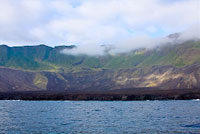

 | |||||||||||||||
|
|
Journals 2008/2009Tom Bogard
September 10, 2008 I woke up to another absolutely gorgeous day! It is the clearest day so far. The motor on the panga has been giving us trouble off and on for a couple of days. Because of the trouble I was asked to stay behind. No problem, I am still not feeling well. I sat on the bow alone as we followed the progress of the panga and watched the volcano. I could see the patterns formed by the lava flows, the brilliant white clouds casting shadows on the flank of the mountain, the dark browns and blacks of the lava contrasted with brilliant blue of the sky, the turquoise of the water, and the green of the mangroves along the shore. It was a stunning site. Other than us, there is no evidence of human presence where we are. I am exceptionally fortunate to be here. I went with Pete and Andrea to shore to do some exploring while Pete photographed Cormorants. We are very privileged to be able to set foot on and explore such highly restricted areas. I tried to walk inland to explore the lava flows. The going again was tough and treacherous - I only made it about 300 meters. One slip into a crevasse or down a ridge and you would be deeply lacerated by the sharp rocks. There are a seemingly infinite number of cracks, crevices, and bizarre shapes in the lava. At rare times the lava can have a smooth surface, and others it seems as if it has been extruded at odd angles out of the flows. I was reminded of the sharpness of the rocks when I noticed that the skin on palms of my hands had been roughed up like very course sand paper just from casual contact with the solidified lava. We saw some beautiful turquoise fish (parrot fish species perhaps) in a tidal pool, a Great Blue Herron, Galapagos Penguins, Sea Lions and pups, Lava Herrons, Brown Pelicans, Cormorants, Green Sea Turtles, Sally's Crabs, Oyster Catchers, and Galapagos Hawks - wow! On the way back to the Queen Mabel in the zodiac we saw Rays jumping into the air. We had seen these before but I did not understand why they would jump like that. Pete explained that they jump in order to rid themselves of Remoras - very cool. The survey crew returned safely and we sailed along the shore in deeper water in the Queen Mabel surveying from the bow. After lunch Gustavo took the crew out again in the panga to survey. The conditions were so rough that he only took three people with him. Within a few meters from the boat the panga disappeared in the trough of a wave only to reappear moments later on the crest of another wave. This was the pattern until we lost sight of them as we sailed to our rendezvous point. I was glad that I did not go. I sat on the bow for a long time watching the island go slowly by - it is all so wondrous! We rounded a point and the sea conditions calmed down enough that Pete, Andrea, and I were able to go ashore. Sea Lions were everywhere. Some had hidden themselves in the voids in the lava flows. They were so hidden that I almost stepped on one as I put my foot down to cross a small crevice. I was chased again for a short distance by a dominant male. I did not know that Sea Lions were such good climbers. I saw many of them at different levels and all the way to the top of cliffs that were 20 meters high! The only way to get there was to climb. They are not graceful climbers, but they do climb. Amazing behavior from these creatures; I never would have expected or believed it unless I had seen it for myself! The landscape here seemed to be slightly older than this morning's. The rocks were rounded, smoother, and more weathered. In the afternoon the panga motor once again would not start. The consensus is that salt water is getting into the electronics of the ignition system. While everyone's attention was on the motor I noticed that we had drifted only about 2 meters from the rocks and that there was nobody in the wheelhouse! I told Gustavo who quickly told the Captain who then sprinted up to the wheelhouse and pulled us away from the rocks at what seemed like the last moment! Just all part of the adventure! At around 4:51 this afternoon we passed over the Equator! I never ever thought that I would be here! This is will always be a milestone in my life. We passed a large semicircular ridge that was several kilometers long and over 400 meters high. The sides were highly eroded and there was thick green vegetation. Pete explained that this was not just a ridge but was half of a volcano, the other half having collapsed into the sea. We were sailing over what would have been the center of the crater. The Equator passes right through the center of this long dormant volcano. I decided to try and eat some dinner this evening to go along with the small lunch that I had had earlier. I hope that all goes well. Look at the bright side, judging by how I am having to cinch up my belt, I am losing weight! Perhaps when I get home I'll write a diet book - I'll call it the Sea Sick/Food Poisoning Diet, a Guaranteed Weight Loss Method! Upon my return home I weighed myself and found that I had lost 10 pounds during my time in the Galapagos. We will be spending the night at anchor pretty much right on the Equator!
|
||||||||||||||


